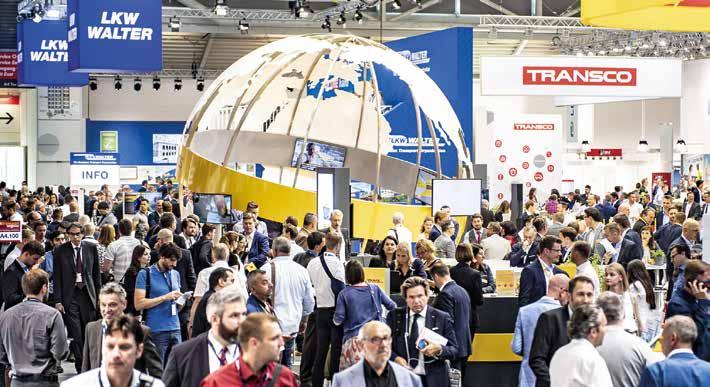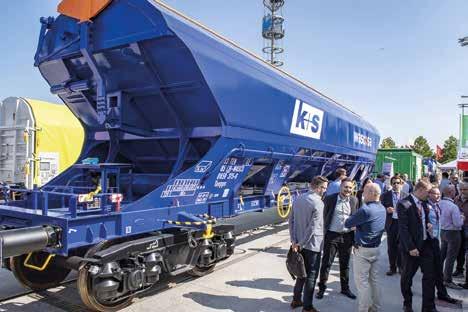
9 minute read
What’s hot at Transport Logistic
BUSTLING MUNICH
REPORT • THE HALLS WERE PACKED AS EXHIBITORS AT TRANSPORT LOGISTIC WELCOMED VISITORS TO A SHOWCASE OF THE FINEST PRODUCTS AND SERVICES FOR THE GLOBAL FREIGHT INDUSTRY
THIS YEAR’S TRANSPORT Logistic event, which took place in Munich in the first week of June, was a complete success and a vibrant adventure. Between the dancing robots, magicians, model trains and virtual reality experiences, the networking opportunities and the host of new products and services pm display were bountiful. Record numbers of exhibitors lined the various halls of the Messe München, with extravagant exhibits and demonstrations of their latest products.
The eye-catching stalls were divided among ten different halls, plus an outdoor rail yard, allowing visitors to strategically work their way through the event to find exactly what they needed: freight transport and logistics services, air cargo service, IT and telematics or transport equipment. Outside, visitors could examine the shining new tank containers and rail solutions that had been brought in specifically for the show. Adding to the atmosphere were cargo containers dotted throughout the atriums and walkways between the halls and a variety of lifting machinery presented in dramatic poses.
Among the dominant topics during the event were the global driver shortage, the need to eliminate environmental damage, the Silk Road initiative, the many different angles in which artificial intelligence could be utilised, and the development of working conditions. Of course, recent global events such as Brexit and the US-China trade war frequently became talking points, particularly as the number of Chinese exhibitors had grown from previous shows. BUSINESS OPPORTUNITIES No matter where you were at Transport Logistic, there was always a space available to network, hold meetings and refill your glass. As record numbers of exhibitors and visitors milled throughout the halls, the new avenues for business connections was, arguably, unsurpassed. Cafés dotted the connecting halls and bars were bountiful,which made arranging meetings with prospective partners even easier.
“Transport Logistic has confirmed its role as the world’s largest intermodal logistics hub. There were 2,374 exhibitors, an increase of 10 per cent, and around 64,000 visitors, an increase of 5 per cent,” says Stefan Rummel, managing director of Messe München.
To provide a better scale of the size and international collaboration to be found at Transport Logistic, 63 countries were present as exhibitors. Officials state that of the 64,000 visitors roughly 30,000 came from outside of Germany, representing 125 countries. “We saw strong growth from China, where the number of exhibitors almost doubled by 30 new ones to 64,” says Rummel. “Chinese companies are increasingly looking for cooperation partners in Europe as part of the Silk Road initiative.”
TRANSPORT LOGISTIC CONTINUES TO GROW AND
Furthermore, there were 25 international pavilions where joint exhibitors provided the very best of different nations and regions such as Luxembourg, Latin America, the Netherlands, Latvia, Sri Lanka and Poland. These international pavilions provided great ease for businesses looking to expand their work in specific regions by removing the need to continuously walk throughout the different halls. The show may have been hosted in Germany, but it was definitely not a national event, nor a European one – Transport Logistic 2019 was a wholly global affair.
NEW GLOBAL ROUTES The future is looking optimistic and some colossal projects are in the making over the next few years – many of which have already started laying their foundations. One of the major plans for Europe is Rail Baltica, an impressive collaboration project that aims to link the Baltic States into the European rail network. The other is the colossal Belt and Road Initiative that will eventually span some 70-odd nations, connect half of the world’s population and tap into a quarter of the world’s GDP. It has been a much-talked about project in recent years, and the conversation shows no sign of slowing down.
The undertaking in the Baltics will develop nearly 900km of rail to link Tallinn, Pärnu, Riga, Panevežys, Kaunas and Vilnius to Warsaw, plus Helsinki (indirectly). The project was started by the Baltic nations of Estonia, Latvia and Lithuania, is partly funded by the EU and, in many eyes, is a symbolic return of the Baltic States to central and western Europe.
Prior to the Second World War, the Baltic States were connected to Europe with 1,435mm rail, but since the middle of 20th century the Baltics have been primarily linked to an East-West railway axis using the Russian gauge 1,520-mm rails. Currently, most railfreight traffic in the Baltics originates from Commonwealth of Independent State countries, particularly Russia, and rail transport services are mainly provided on the existing Russian gauge system, making it difficult and costly to connect the Baltics with the rest of the EU via Poland.
The Rail Baltica project plans to eliminate the missing rail link of the EU’s North Sea–Baltic TEN-T Core Network Corridor, ensuring full integration of Estonia, Latvia and Lithuania into the single European railway area, creating a spine of rail connections across the cooperating countries. The aim is to link existing rail hubs with ports and airports, remove bottlenecks, improve the infrastructure to allow high-speed travel (up to 120 km/h for freight) and provide easy access to the three multimodal terminals of Muuga in Estonia, Salaspils in Latvia and Kaunas in Lithuania.
The planning stage for Rail Baltica has been completed and the initial construction projects have begun. The design stage is to be completely finished by 2022 and the whole construction is due to end in 2026, with the first train launch happening shortly after. It will be an exciting project to keep track of throughout the next few years and to see how the industry utilises the new developments.
ALWAYS KNOWING Digitisation and being able to procure data at any moment from any place in the world has become one of the greatest recent additions to the transport of hazardous cargo. There were countless exhibitors demonstrating their latest upgrades to existing systems or highlighting new software solutions to utilise every conceivable part of the transport system.
Over at Schmitz Cargobull, new sensors to track everything from cargo temperature to tyre pressure were on display to make sure that users at running at optimum efficiency. Of course, being able to monitor and control temperature is nothing new, but the constant stream of updates to existing concepts keeps on improving the quality of data available. Having the ability to utilise data can frequently provide savings, improve upon efficiency and speed and will also highlight with greater clarity any issues that should arise.
Bespoke solutions are rapidly becoming the norm in the industry. Although there can be a saving with pre-existing packages, being able to have a digital solution that is completely tailored to a company’s processes and unique customer base swiftly pays for the additional cost. The Information Factory demonstrated what its tailoring can offer to a diverse range of businesses across the industry, particularly when it comes to analysing data. CEO Robert Jordan was keen to invite passing delegates into the stand for a hot drink and a thorough introduction to the boundless capabilities The Information Factory can provide worldwide – and the proof is in the sterling reviews from bigname clients such as DHL and Panalpina. From logistics to contract management, a personalised solution to harness the most from data is possible. »

“Transport Logistic has provided us with a broad and deep perspective on the logistics world plus the key trends and challenges it faces,” says Gordon Steward, marketing director at The Information Factory. “We first exhibited in 2017 when we were primarily serving clients in the Express sector of logistics. The exposure and knowledge gained from attending Transport Logistic has helped us gain clients in the freight forwarding, sorting and handling equipment and consolidator sectors. We also have shipper and end-user clients and are in active discussions with third-party logistics.”
Even though The Information Factory’s specialism is in data, the wider talking points of the event crossed boundaries and included all forms of business. Steward continues: “The big issues which struck us were the Belt and Road Initiative, urban logistics and the shortage of drivers. Sustainability and environmental issues also featured prominently amongst most exhibitors.
“The Silk Road programme covering both rail, road and ocean routes between China and Europe will obviously have a major impact on the logistics industry as well as impacting the economies at both ends of the route plus those through which the road passes. And, there is sure to be a geo-political impact from such a huge investment in physical infrastructure.”
Transport Logistic is a key event for businesses such as MRI Intermodal (formerly RAM Intermodal) as many existing and prospective clients descend on the event. “Transport Logistic is such an important show for us, as most of our current and potential clients in the tank industry are located in the ITCO Village or in the same hall,” says Nicola Byers of MRI Intermodal. “It was a very successful event for us this year as we rebranded to MRI Intermodal Software on 31 May 2019 and this was an excellent way to get the message out to the market.” In addition to newly branded giveaways, there was a drinks reception on the Thursday afternoon to celebrate the MRI Intermodal brand launch. “We also held a number of demos at the stand and got a chance to meet some new prospective clients for the first time,” continues Byers. “There were also many client meetings; always an important part of the show for us.”
The Software-as-a-Service specialists Transporeon unveiled its latest three-pronged approach to data-driven solutions. The three services, Offer Retrospect, Offer Prediction and Connecting Load Agent, support shippers by integrating objective criteria into the transport assignment and execution processes. Through the use of anonymised data available on the Transporeon platform, the new solution is able to evaluate the stored data statistically and craft forecasts through predictive analytics.
For some years now, the tank container industry has found Transport Logistic to be a useful focus and the International Tank Container Organisation (ITCO) has provided a home for its members in the ITCO Village. This year, Hoyer made the most of the record foot-fall with informative and passionate talks about its latest Smart Tank innovations. The introduction of new digital technologies to tank containers for a fleet the size of Hoyer’s is a challenge, but one it is tackling head-on. Of the 37,000 tank containers in the Hoyer fleet, 5,000 have already been upgraded and a further 8,000 tank containers are planned to be adapted each year.
“Transport Logistic is always a benchmark for Hoyer,” says Thomas Hoyer, chairman at Hoyer. “This year’s trade fair was again a complete success for us. As well as conversations and a lively exchange of ideas with customers and partners, we used the trade fair for discussions about topics of current concern in the sector. Our Smart Tank formed a highlight that was very well received by the visitors.” »

ADVANCES IN INFORMATION TECHNOLOGY ARE
OPENING NEW POSSIBILITIES IN ALL PARTS OF THE



